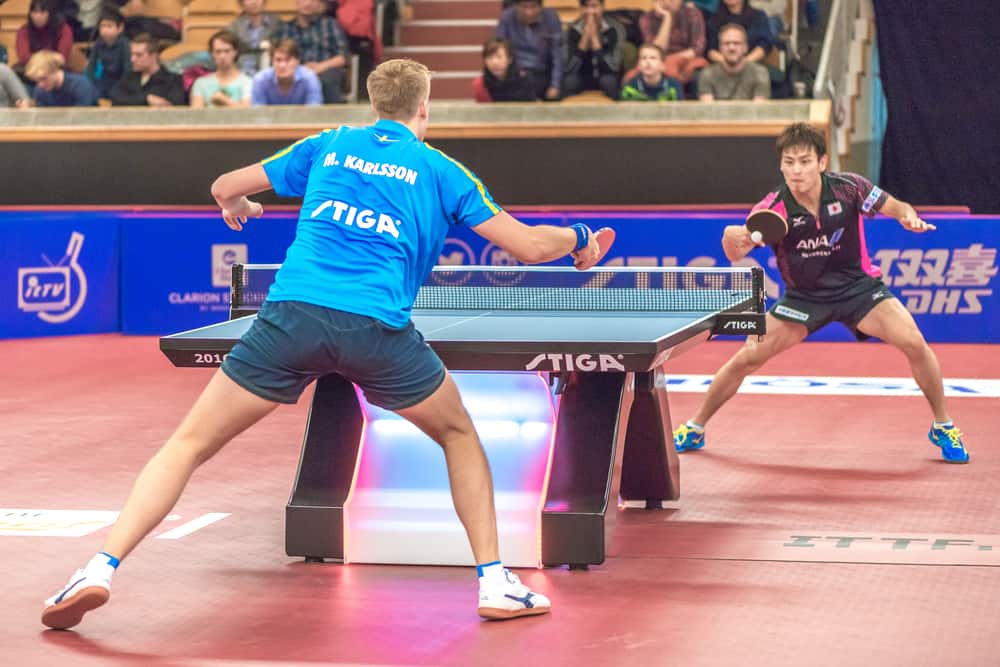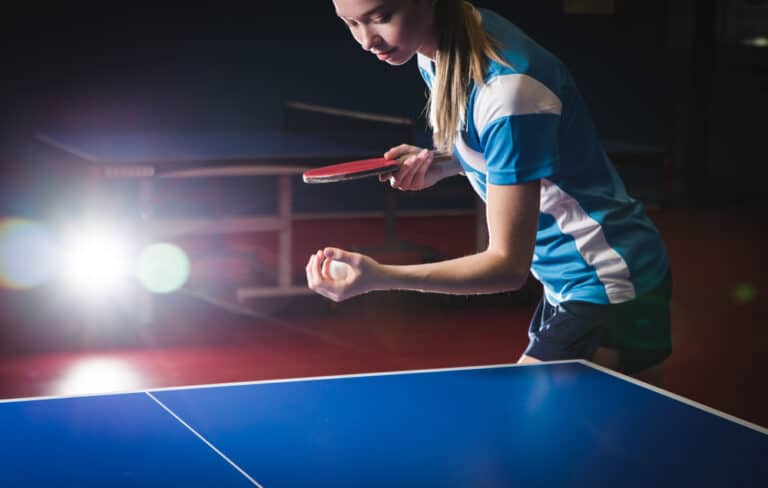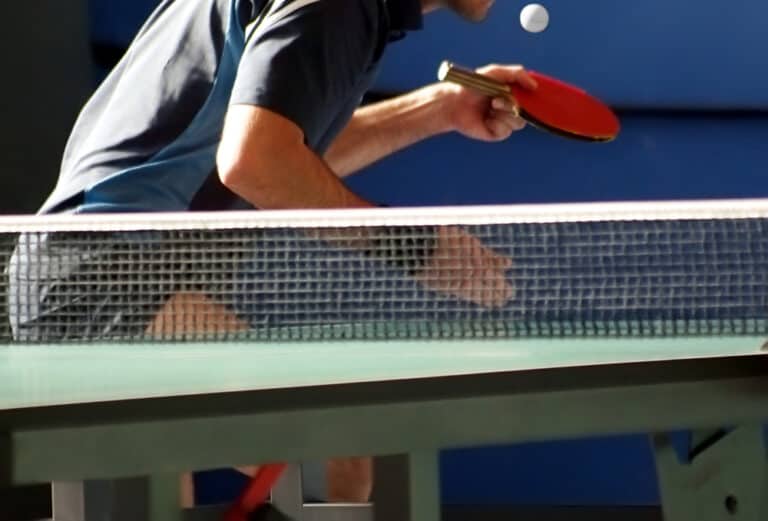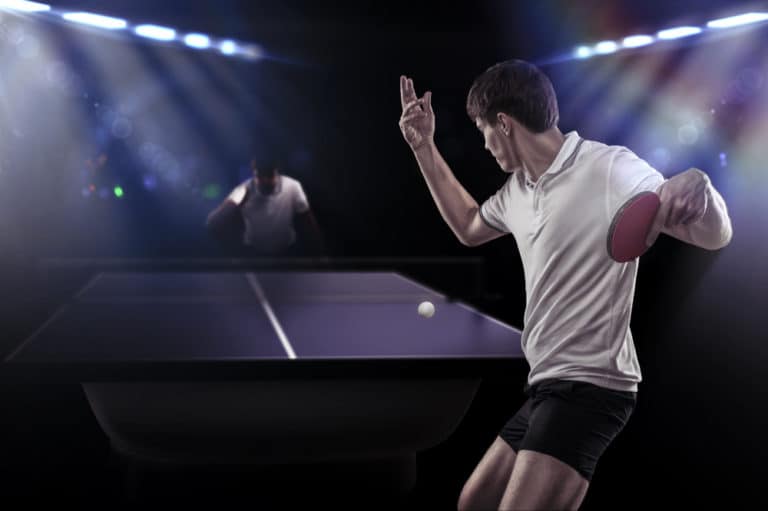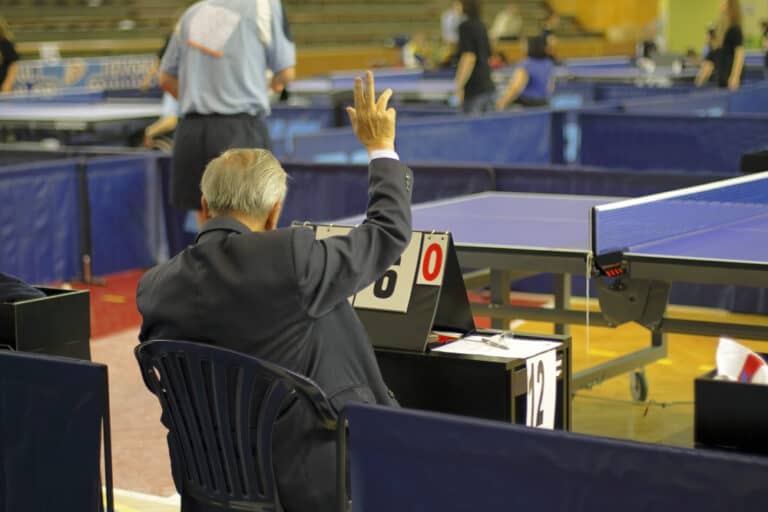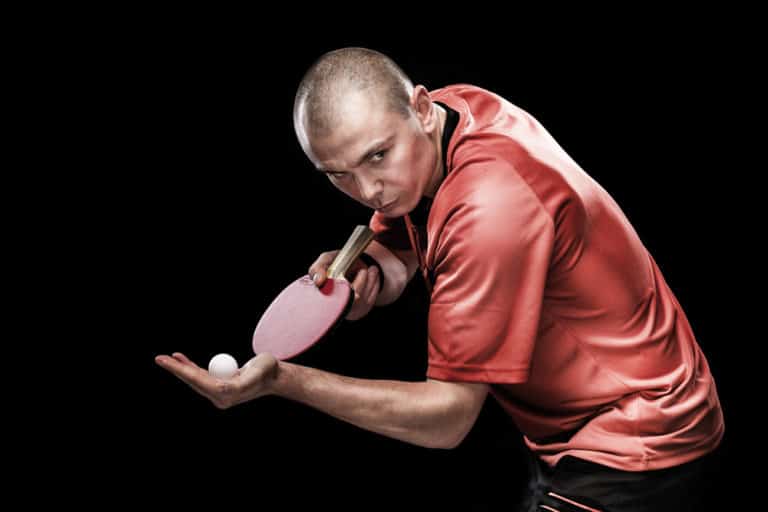Is Height An Advantage In Ping Pong?
Watching a game of ping pong is mesmerizing. Players’ agility close to and behind the table relies on quick timing and show-off spins and tricks. The game’s low and strong shots make the ball fly like wind speed. Players have different heights. Have you wondered if the height of ping pong players is an advantage?
A player’s height can be an advantage and a disadvantage in ping pong. Height is a variable a player can’t choose. Ping pong is a technical game that takes mind control and needs steady and fast footwork. A player’s height influences their game which relates to the standard 30 inches high ping pong table.
One quickly notices in a game of ping pong (or table tennis) that players’ physique relates to the table, either close by or further back. No doubt, ping pong is about agility and body control. A ping pong player’s leg strength is as crucial as their wrist movements and the twists and turns of their torso. Whether a player’s short or a taller height affects their play is worth looking at.
Does Height Matter In Ping Pong
Ping pong, one of China’s national sports, rears some of the world’s best players from a young age. Players’ heights vary, and whether tall or shorter influences their game. How this impacts is seen in their skills and their posture when playing. Ping pong players’ agility and skill stand out as quick-timed hits and spins.
The first-hand experience that most of us have with playing ping pong with a shorter person is when we play with a kid. This is when we understand what height means to the ping pong table. The height of a ping pong table is standard 30 inches high. Whereas the table is below an adult’s waist, it’s in line or above that of a kid.
The height of the table affects one’s maneuverability and will demand different skills. Standing at a different height will influence how we play. Depending on your height, your arm’s reach differs, influencing how easily you can get to a ball and return it. And shorter players also have shorter arms and shorter reach.
There is no equivalent of a golfing handicap when competing in ping pong. Ping pong players aren’t grouped in terms of their heights when playing. Players adapt by standing further back from the table if they’re taller or closer if shorter. Players also crouch to play low shots. For taller players, this means they’ll use their quads (thigh muscles) more.
The first thought is to consider a taller player’s height as an advantage. You might even think of long arms that can quickly stretch, reach and hit the ball. Or that being short demands more agility and can be a disadvantage. One realizes there’s more at play, but at the same time, one can’t exclude the role that a player’s height has on the game.
Ping pong demands accuracy and speed, and height influences the game played.
Factors That Influence Ping Pong Players
Ping pong players are skilled, fit, and play rigorously to reach and smash the ball. Taller players have the advantage of reaching up and quickly returning a ball. The height of players varies, and this makes the game interesting. The deck of the ping pong table is a standard 30 inches high, influencing the game of taller and shorter players.
Height Is Not Always An Advantage
Ping pong players’ height has an influence, and this is not necessarily an advantage. There are scientific measurements of athletes’ physique (anthropometry), and these averages are much the same as the height of ping pong players. From the data of table tennis players at the Rio 2016 Olympic Games, there are the following averages:
- In all sports, the average height for athletes is 5 feet 8 inches
- In table tennis, an average of 5 feet 6 inches
- Table tennis (women), an average of 5 feet 4 inches
- Table tennis (men), an average of 5 feet 8 inches
The height of the world’s top men ping pong players varies by a few inches. When playing on a table deck of 30 inches, a variance of 5 inches is considerable. Below are the top players’ heights:
- Left-handed Lin Yun-Ju is 5 feet 9 inches tall
- Ma Long, the reigning Olympics champion nicknamed ‘Dictator’ and ‘Dragon’, is also 5 feet 9 inches tall
- Fan Zhendong is 5 feet 8 inches
- Dimitrij Ovtcharov is 6 feet 1 inch tall
- Timo Boll, a left-handed player, is 5 feet 11 inches
These heights of top ping pong players are within a range of five inches looking at Zhendong and Ovtcharov (see above). These heights (relative tallness) do not indicate a good player.
Disadvantage Of Being Tall
Unlike soccer and basketball, even tennis, ping pong is less about height. Ping pong players have even listed disadvantages to being tall. These include a taller player’s stance with the ping pong table at 2.5ft high and an additional 6 inches for the ping pong net. Some have mentioned that being tall has physically impacted them.
Some of the key points are:
- Injuries to knees – posture and crouching of taller players cause strain and stress on knees
- Less powerful hits – taller players have to move less to get the ball and hit. Without moving their body, they hit with less force
- Less footwork – the ball is within arm’s reach and not moving to reposition
In the latter case, a tall player plays with a straight arm, whereas one’s best ping pong stroke is with your elbow bent. But being tall means you can do powerful smash hits.
Taller players’ strength is still moving rather than stretching for the ball. Shorter players often wish for more arm’s length. Because of their height, shorter players can crouch lower, making it easier to play. The 30 inches high table, much lower for a taller ping pong player, means they play with their knees bent. The position puts strain on the knees of taller players.
Playing styles vary and, at the same time, influence the game and the caliber of players. Being tall is not an outright handicap, nor is being short. But what does happen is that the taller player can lob the ping pong ball and make it difficult for shorter players to return. Taller players often use strong backhand drives and loops.
Taller players are thought to play further from the table and have a defensive strategy. Taller players have a relatively freer swing too. Each height, tall or less so, competes at different levels. Players’ height in a game, tall or shorter, can be summed up as:
- Shorter players appear more agile as they have a shorter arm reach
- Taller players’ reach is longer
- Taller players move to play shots near their body
- Taller players are relatively less agile than shorter players
- Taller players play by bending down low
- Shorter players just need to slightly crouch
Though height – tall or shorter – is a determinant in just the kind of game that will be played, there’s more. Playing ping pong is a skilled game and takes training and stamina.
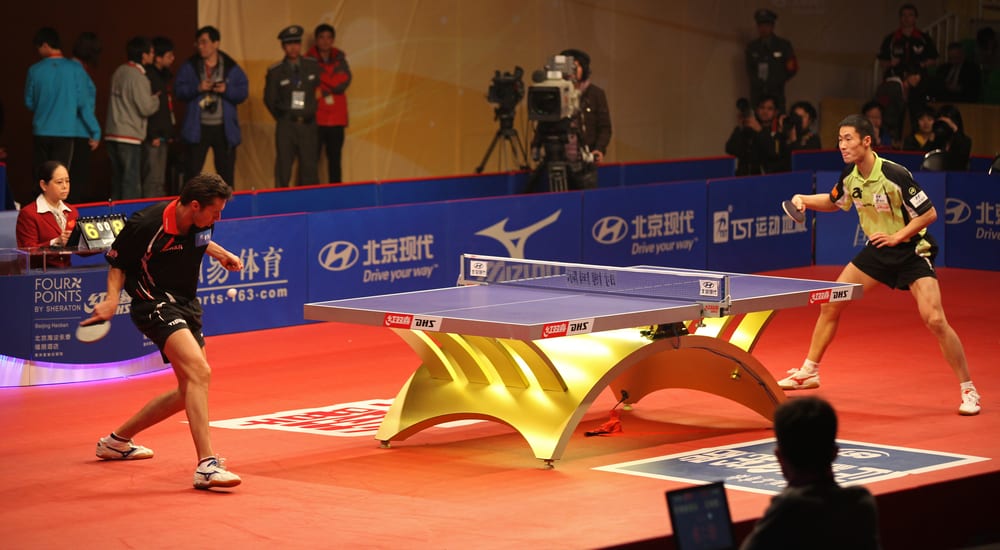
Skill Is Greater Than Height
Ping pong is a technical game that demands speed of play and solid power. A player’s height can be to their advantage, as seen in Fan Zhendong, which has been described as the strength of his forehand. The table height affects ping pong players’ stance or posture (as seen above). A ping pong player needs the skill and agility to play on the raised table.
Quick timing matters as much as hitting low and strong shots. Players have a string of nerves, ready to play under pressure. They are always on the lookout for opportunities to play an attacking shot. The skills include stepping back and forward, hitting brushstrokes, forward top spins, and powerful backhands.
In all this, a player’s relationship is with the height of the playing deck, which in the case of taller players is lower than for shorter players. In Fan Zhendong’s case, the champion can put more spin on the ball. He can hit shots harder and uses his leg strength – quads – and torso to get more power.
With such leg power, agility, and footwork, Zhengdong masters a forehand topspin, which many believe is related to his height. Ping pong is a series of quick wrist movements, except for the smashes. Playing a tactical game means that shorter players are quicker on their feet and taller players have to bend their knees to lower their center of gravity.
Smaller players also are thought to have the advantage of quick and strong arm movements.
Advantages And Disadvantages Of Height
Ping pong is a game in which a player needs to be in control. You can see this in the manner of play, the calculated and skilled delivery of every hit. Unlike in tennis, with ping pong, the serve is less to do with height. It is almost as if the game depends on the serve – one strong serve so fast that it isn’t returned.
Though some players say being close to the table is an advantage – a shorter player has the advantage here. Once the game is in action, the players control the hitting speed. For taller players, this is a position in which their knees are bent to keep them as low as they can be to the height of the ping pong table.
This is where the shorter players appear to have an advantage, only if the shorter players crouch low. If shorter players don’t crouch, taller players who do, have an advantage. This position is taken to return a ball fast. Ping pong players have upper solid thighs and legs to maintain this stance and ensure the ball is hit with force.
From a tactical point of view, the taller players must use their low, bent-knee posture to play close to the table. Some might even say that taller players are at a disadvantage as playing in this bent position is strenuous. Less tall players don’t have to play in this bent-knee posture. The endurance levels of taller players are put to the test and less so that of shorter players.
Taller ping pong players play a specific game that many have described as defensive. Taller players can play further away from the table. Their style of playing appears freer here.
The ping pong table’s height (30 inches), the playing size (9 x 5 feet), and the height of the ping pong net (6 inches) determine how the game is played. One can see how the height of the table influences the game. And for taller players, the table’s height is more challenging. The taller players must alter their stance or play further away from the table.
Some of the most typical responses on if height is a disadvantage is that height gives a player more reach. Some also ask about women players and their height and mention that taller women don’t necessarily play ping pong. Interestingly, women and men can compete on equal terms in ping pong, which is suitable for women with a competitive edge.
A taller height demands that ping pong players adapt their styles that match their playing. Shorter players capitalize on the agility needed because of their shorter reach. Shorter players in the range of 5 feet 2 inches have to use their height as an advantage rather than a disadvantage.
Ping Pong As Strategic Focus
Watching a game of ping pong is tense for viewers and players. The speed of play is associated with a heightened state of mind. Ping pong players will tell you that every thought affects how they hit the ball. They read their opponent at the moment, strategize on the spot, and aim to deliver fast and strong balls. Players’ responses in a game do depend on their heights.
A player’s height influences the type of return hit to expect and a player’s readiness. Studies show that a player’s quick response is related to their height on a neurological level. This is related to the flow of nerve impulses in a player’s brain. Less tall players are thought to have nerve impulses from the brain that travel at a speed of more than the average 300 feet per second.
This puts the shorter-height players in a different position regarding their quickness in playing. It has to do with the cues from their brain. What’s suggested is that a shorter player reacts with a difference of one foot. This gives the player an advantage of 1/300 seconds to suss out how to play. The shorter player, therefore, will be able to anticipate and act faster than the taller player.
With 1/300 seconds, the shorter player’s reactions are faster – an advantage measured in time that a shorter (in height) player has to adjust their racket!
Conclusion
Ping pong players don’t have to be a specific height to play well. A player’s agility and on-the-spot tactical decision-making skills are often winning ones. Ping pong is played fast and is highly skilled. A player’s height determines the kind of game played.
Ping pong is a game that’s both attacks and defense. Depending on the ball’s trajectory, a player’s height can be a physical disadvantage or advantage. For a tall player, a victorious win can differ from one for a shorter player. But in the mind of a ping pong player, it is tactics that reign.
References
- https://www.quora.com/Is-height-an-advantage-or-disadvantage-in-Table-Tennis
- https://howtheyplay.com/individual-sports/All-About-Fan-Zhendong-Table-Tennis-Superstar
- https://www.medicinenet.com/height_men/article.htm
- http://www.guardian.co.uk/notesandqueries/ask/0,,-25477,00.html
- https://www.quora.com/Why-does-Fan-Zhendong-have-a-much-more-powerful-forehand-than-most-European-table-tennis-players-How-can-I-copy-his-forehand
- https://www.quora.com/Is-height-an-advantage-or-disadvantage-in-Table-Tennis
- https://www.topendsports.com/sport/table-tennis/anthropometry.htm
- https://en.m.wikipedia.org/wiki/Lin_Yun-ju
- https://en.m.wikipedia.org/wiki/Ma_Long_(table_tennis)
- https://en.m.wikipedia.org/wiki/Dimitrij_Ovtcharov
- https://en.m.wikipedia.org/wiki/Timo_Boll
- https://en.wikipedia.org/wiki/Fan_Zhendong

